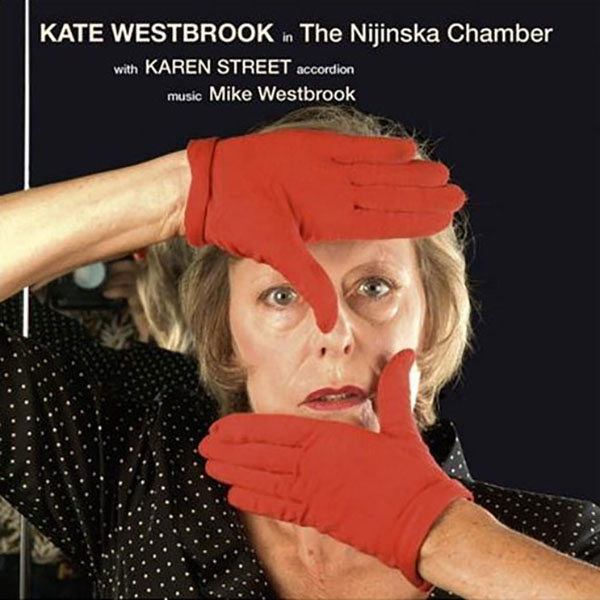
by Ian Mann
November 16, 2006
/ ALBUM
There is clearly a cult following out there but I don't see "The Nijinska Chamber" bringing many new converts to the fold.
“The Nijinska Chamber” is the latest addition to the fiercely individual Westbrook oeuvre. Husband and wife team Mike and Kate Westbrook have collaborated on a series of challenging and idiosyncratic albums over the years creating a highly distinctive and personalised sound in the process. They have combined elements of jazz with classical music, cabaret and chanson to create their own unique vision. Many of their albums have a theme or concept, often linked to figures in other branches of the arts.
Their album “Art Wolf” based on the life and works of the Swiss painter Caspar Wolf is reviewed elsewhere on this site and covers something of the Westbrooks musical histories.
This latest album is released under Kate’s sole name. Nevertheless the music has been composed by Mike with Kate as usual providing the lyrics. Tellingly Mike does not play on the album itself, the only instrumentation other than Kate’s voice being the accordion of Karen Street.
On this occasion the album tells the story of Bronislava Nijinska the Russian ballet dancer and choreographer who died in 1972. Although somewhat overshadowed in her lifetime by her brother, the famous dancer Vaslav Nijinsky she was nevertheless the first important woman choreographer.
Westbrook sets the album in 1950’s America and shows Nijinska, then living in California looking back over an artistically rich but sometimes troubled life. Snatches of 1950’s American pop hits such as “Ghost Riders In The Sky” weave their way in and out of the narrative.
Westbrook traces Nijinska’s childhood in St. Petersburg and chronicles her sufferings in the war years. She examines Nijinska’s working life with Diaghilev and the Ballets Russes . The company was based in Monte Carlo and was enormously popular in Paris. Through the Ballets Russes she knew such figures as Stravinsky, Bakst and Picasso and, somewhat incongruously I thought, Mickey Rooney. On the track “Allegra’s Song” Westbrook also looks at Nijinska’s work as a dance teacher. This track also features a small vocal cameo from Karen Street.
Nijinska’s love life is also scrutinised. Her lesbian tendencies are touched upon in “Kiev Girl” but nevertheless she was twice married bearing a son who was tragically killed in a car accident and a daughter who subsequently carried on her work. In addition to all this was her doomed love for the great Russian bass singer Chaliapin, the true love of her life but to whom she was never married.
Westbrook’s narrative sees Nijinska having to give up dancing herself due to arthritis but still continuing as a choreographer and teacher. Now happily living in the US she travels to Venice to stage her signature work Les Noces. Whilst in Venice she visits the grave of her former mentor Diaghilev on her 80th Birthday.
On her death Westbrook’s lyrics have Nijinska the “She Crow” of dance rejoining her late brother Nijinsky, the “Storm Cock” in a dramatic finale and a mirror to the earlier “Song Of St. Petersburg.”
Musically everything revolves around Westbrook’s voice. Her vocals are haunting, dramatic and unsettling mixing singing with the spoken word. There is a clear sense of the actor at work. Westbrook’s lyrics range from the poetic to the earthy. She really gets inside the character of Nijinska. Although the music is a celebration of a full life, at times it is melancholy and harrowing. Street’s accordion shadows Westbrook’s every inflection with grace and acumen. Street evokes perfectly the sound of 1920’s Paris, on other occasions her sound is fleetingly reminiscent of a church organ.
However, for all it’s positive points I still found this a difficult album to actually enjoy. The stark instrumentation means that “The Nijinska Chamber” lacks the musical breadth of “Art Wolf” and there is little instrumentally to divert the listener’s attention from the album’s sometimes dark central theme. At times the album sounds too self consciously “arty”, an impression which the use of spoken word only encourages. Lyrically it seems to be more oblique than “Art Wolf”.
Having said that it took several listens to really appreciate “Art Wolf” and to get to genuinely enjoy it. “The Nijinska Chamber” is a typically uncompromising Westbrook record and like it’s predecessor is a success in it’s own terms. However, I found it rather forbidding as a whole and it is a record I found I admired rather than enjoyed and I don’t envisage myself returning to it very often. Recommended only to the most committed listeners.
Leaving aside my personal misgivings 2006 has been a good year for the Westbrooks with a series of documentaries on their music being aired on Radio 3’s Jazz File slot on Saturday evenings under the title “Chanson Irresponsible”. Radio 3 has also aired a concert recording of an extended “Art Wolf” line up featuring guest drummer Sebastian Rochford. And only last week the Westbrook Village Band played a triumphant concert at the London Jazz Festival which was also covered by Radio 3.
There is clearly a cult following out there but I don’t see “The Nijinska Chamber” bringing many new converts to the fold.
blog comments powered by Disqus